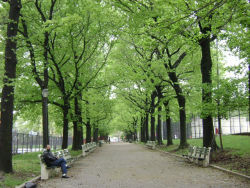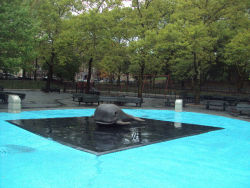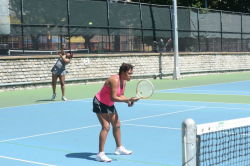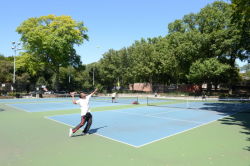Lincoln Terrace / Arthur S. Somers Park
Lincoln Terrace Park
What was here before?
The area was mostly rural and farmland until it was developed in 1865 by Charles S. Brown. Brown purchased a section of farm and meadowland and built 250 frame houses, hoping to lure the working class from lower Manhattan and western sections of Brooklyn to his modestly priced homes. Brown was confident that he wouldn't be able to persuade the upper middle class to move to the area known as "Brownsville" due to its unpleasant location downwind from the foul odors of the marshes and bone-boiling factories near Jamaica Bay.
How did this become a park?
The City of Brooklyn began purchasing land for the 21-acre park between 1895 and 1897. The park was developed with grading, tree and shrub planting, and an iron fence. During World War I, anti-aircraft gun bases were discreetly placed within the park. Additional parcels were acquired between 1916 and 1935, including the northeast tip, which had been part of the Interborough Rapid Transit (IRT) subway extension in 1916 but became parkland in 1928. The park's separate sections were unified with the closure of President, Carroll, and Crown Streets between Rochester and Buffalo Avenues. Yiddish-speaking residents knew it as “Kitzel Park” or “tickle park.”
This park, straddling Brownsville and Crown Heights, was converted during the 1930s by the Works Progress Administration. It serves a diverse, multi-generational community and offers various functions, though its earlier design sometimes compartmentalized these elements, affecting the park's overall aesthetic.
In 2019, the playground was renovated to offer a more dynamic and interactive experience for children, ensuring a smoother flow between play areas and prioritizing sightlines for parents. The redesign also created spaces where children can gain a sense of independence. Entryways were expanded to be more welcoming, and the park features a public plaza, a mounded area, and a rain garden for social interaction. A variety of trees and plantings help provide shade and reduce the "heat island effect," while sustainable materials were used in playground furniture. The redesign successfully meets both community and environmental needs, blending aesthetically with the larger park.
Who is this park named for?
Named for President Abraham Lincoln (1809-1865) and terrain of the park.
Abraham Lincoln, born in a log cabin in Kentucky and mostly self-educated, moved to New Salem, Illinois, in 1831, where he worked in various jobs while studying law. Elected to the Illinois state legislature in 1834 and becoming a lawyer in 1836, Lincoln later served in the U.S. House of Representatives from 1847 to 1849. Though he lost Senate races in 1856 and 1858, his debates with Stephen A. Douglas gained him national fame. In 1860, he was elected president, and seven southern states seceded before his inauguration in 1861.
During the Civil War, Lincoln issued the Emancipation Proclamation in 1863 and delivered the Gettysburg Address. He was re-elected in 1864, but was assassinated by John Wilkes Booth at Ford’s Theater in April 1865, just days after General Lee’s surrender.
In 1932, the Board of Aldermen named the west portion of a park after Arthur S. Somers (1866-1932), a local philanthropist and civic activist.
Somers dedicated his career to serving Brooklyn's best interests. He was appointed to the Brooklyn Board of Education in 1892 by Mayor David A. Boody, serving until 1896, when he resigned. Later in 1896, Mayor Frederick W. Wurster appointed him as a civil-service commissioner, a position he held until Brooklyn's consolidation with New York. In 1898, Mayor Robert A. Van Wyck appointed him to the Brooklyn School Board, where he was elected to represent Brooklyn on the central board of education. Somers was also involved with the Hanover Club, Brooklyn Lodge No. 22, B.P.O.E., and St. Vincent de Paul's church.
Check out your park's Vital Signs
Clean & Safe
Green & Resilient
Empowered & Engaged Users
Share your feedback or learn more about how this park is part of a
Vital Park System




